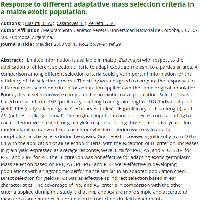Resumen
- Limited information is available in maize (Zea mays L.) with respect to the application of different selection criteria to adapt exotic germplasm to a particular area. A comparison among different selection criteria could give important information for the efficiency of the selection process. The study was designed to compare the responses to different mass selection criteria for adaptation applied over the same original population. Four cycles of selection were completed for an exotic maize population. Selection was based on six criteria, PEG (prolificacy, ear length and grain length); RTO (individual plant yield); PRE (early silk emergence); HI (harvest index); PE (prolificacy and ear length), and ASI (anthesis-silking interval). The original population and four cycles corresponding to each criterion were tested for grain yield response during three consecutive years. Ten random families derived from each four-selection criterion were evaluated for morphological characters during two years. Grain yield increased significantly from CO to C4 with the application of all selection criteria, with the exception of HI criterion. Increases in grain yield expressed as average response, were 3,2% for PRE, ASI and RTO, 3,1% for PEG, and 2,8% for PE The HI criterion was not effective for adapting exotic germplasm. Mass selection based on PRE, ASI, PE, PGE and RTO, were effective in developing populations with an agronomic performance similar to an adapted population check. Direct selection for yield (RTO) was as effective as indirect selection based in ear characteristics. The advantage of PRE and ASI criteria in comparison with the other criteria applied during this study is that PRE and ASI are more simple and accurate to measure a large number of germplasm introductions in field experiments.
